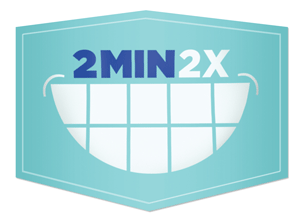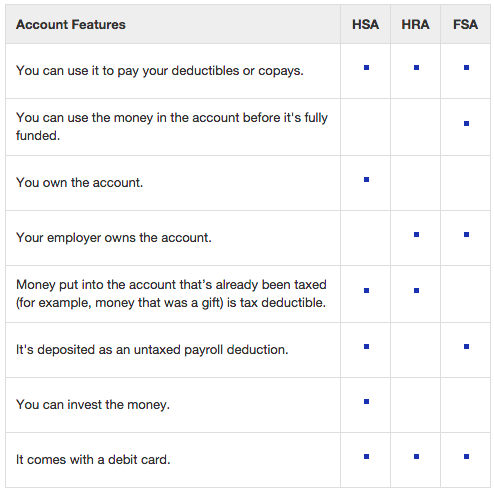SUMMER: Sports, Pool, and FUN = Knocked Out (Avulsed) Teeth
SUMMERTIME!
 Fourth of July is around the corner and kiddos are running around and having FUN! In the Midwest heat, a lot of fun involves water, and therefore, slippery surfaces. Roughhousing, baseball, and being a child, all cause collisions. Teeth inevitably get knocked out or damaged.
Fourth of July is around the corner and kiddos are running around and having FUN! In the Midwest heat, a lot of fun involves water, and therefore, slippery surfaces. Roughhousing, baseball, and being a child, all cause collisions. Teeth inevitably get knocked out or damaged.
Dentists see many trauma-related tooth injuries this time of year; especially in kids! When a tooth is knocked-out, this is medically called an “avulsed” tooth. A chipped tooth (photo below) is something totally different than a tooth that is knocked out; an avulsed tooth is completely out with its entire root intact.
“OMG, a kid just knocked out a tooth.”
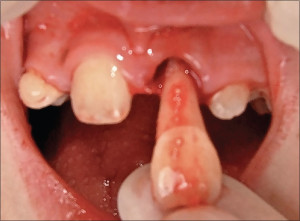 REDUCING THE TIME OF THE TOOTH OUTSIDE OF THE MOUTH is THE #1 KEY to SUCCESS!
REDUCING THE TIME OF THE TOOTH OUTSIDE OF THE MOUTH is THE #1 KEY to SUCCESS!
If your kiddo is under Age 6, likely, an avulsed tooth is a primary/baby tooth and should not be re-implanted. However, any mouth trauma, even in a kid without permanent teeth, should be evaluated to monitor their permanent tooth transition. ONLY permanent teeth should be repositioned.
TEETH 101: HELP! A Tooth Is OUT!
ARE YOU A PARENT / COACH / LIFEGUARD? So…you’re around kids…
If you encounter an avulsed (knocked-out, with the root) permanent front tooth;
follow these simple steps for the best outcome for this kiddo’s smile and CALL a dentist:
-
Keep the “patient” calm. It will probably be bleeding, and the kid likely be losing his/her mind. You should be calm. You CAN handle this.
-
Find the tooth and pick it up by the enamel/crown (the part of the tooth that shows in the smile) NOT YELLOW LONG PART; which is the conical “root” of the tooth. (see photo directly below right – where the gloved blue hand is touching the tooth)
-
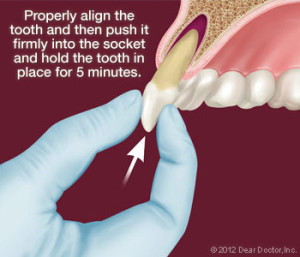 If the tooth ROOT is dirty, either, place the tooth in the “patient’s” mouth; they can spit out any blood and dirt while keeping the tooth in the mouth, if it’s not a choking hazard, OR wash it BRIEFLY (less than 10 seconds) under cold running water. You should be mentally ready to re-position the tooth in the socket IMMEDIATELY, as close to the smile line of the mirror/neighboring teeth as possible.
If the tooth ROOT is dirty, either, place the tooth in the “patient’s” mouth; they can spit out any blood and dirt while keeping the tooth in the mouth, if it’s not a choking hazard, OR wash it BRIEFLY (less than 10 seconds) under cold running water. You should be mentally ready to re-position the tooth in the socket IMMEDIATELY, as close to the smile line of the mirror/neighboring teeth as possible. -
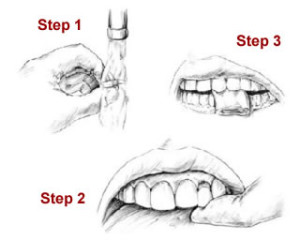 REINSERT THE TOOTH. Make sure the correct side of the tooth is facing out. No need to push hard. Likely bloody bubbles will come out as it squishes into place.
REINSERT THE TOOTH. Make sure the correct side of the tooth is facing out. No need to push hard. Likely bloody bubbles will come out as it squishes into place. -
HAVE THE “PATIENT” BITE ON A RAG OR CLOTH. It will be tender and starting to swell. This is may be a painful, but its an EXTREMELY important step!
-
IF YOU CAN’T/DON’T FEEL COMFORTABLE TO REINSERT THE TOOTH, place the tooth in one of three places:
- Hank’s Balanced Solution (seen right, available in many First Aid kits)
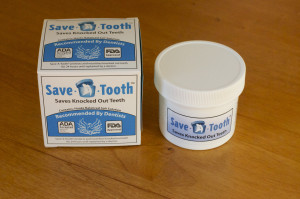
- In the side of the cheek of the “patient,” sandwiched between their lower teeth and cheek, if it’s not a choking risk.
- In MILK
- DO NOT STORE THE TOOTH IN WATER – a teaspoon of salt in a cup of bottled water in a clean container can work in a pinch.
SEEK EMERGENCY DENTAL TREATMENT IMMEDIATELY. Time is of the essence.
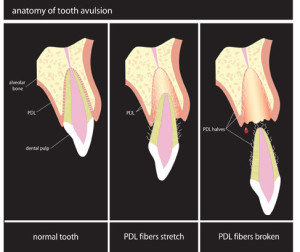 After dental intervention and implantation – there are many different outcomes; which may include immediate splinting (think: bonded retainer to hold it in place), root canal therapy, or unfortunately, complete loss. Cross your fingers for a complete recovery! Later in tooth-life, the tooth may die, ankylose (get stuck in the bone), change colors, or need a root canal or crown.
After dental intervention and implantation – there are many different outcomes; which may include immediate splinting (think: bonded retainer to hold it in place), root canal therapy, or unfortunately, complete loss. Cross your fingers for a complete recovery! Later in tooth-life, the tooth may die, ankylose (get stuck in the bone), change colors, or need a root canal or crown.
There’s a hopeful chance that the tooth will be okay, IF given prompt and proper treatment. Prognosis is always unknown, but following these steps will give the patient/tooth a hopeful outcome!
EXCEPTIONS:
- Of course, if the “patient” experiences bleeding that can’t be controlled after five (5) minutes, dizziness, loss of consciousness, or intense pain; call 911 or go directly to the Emergency Room (ER).
-
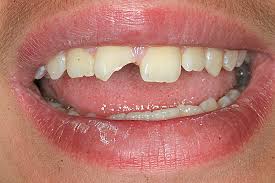
Chipped tooth
If there is only a tooth “crown” broken at the gum-line or the tooth is chipped, and the root is still in the bone; it will not magically glue back together. Call a dentist.
- The maxilla (upper jaw bone) is fractured. Go to the ER immediately.
- The root is in pieces/split in half.
- It’s a primary “baby” tooth: Re-implantation could cause the primary/baby tooth to ankylose, aka, be stuck; and cause many more problems later when the permanent teeth are ready to erupt (think: expensive braces/orthodontic bills!). Consult your General/Pediatric Dentist; but usually these are just lost teeth. Your toddler will have that adorable gap for several years of Holiday Cards!
If you encounter a dental emergency like this, call your regular dentist. If you don’t have a regular dentist, feel free to give us a call at (913) 788-7600.

Kelly McCracken, DDS
If you want to get to know our office, request to schedule an appointment online! Consultations are always complimentary, and as a small business in Kansas City, we appreciate the referrals and strive to deliver our mission of, “QUALITY, HONESTY, and EDUCATION” in a comfortable and fun environment for your family.
We’d love to have you as part of OUR dental family! 8915 State Ave., Kansas City, KS 66112. (913) 788-7600
**This post was for educational purposes and tips – not a diagnosis or recommendation(s) for treatment; if you, or someone you care for, has suffered a trauma as described above, seek immediate dental attention; and if your dentist or our office is not available, don’t hesitate to contact your primary care doctor or go to the ER.
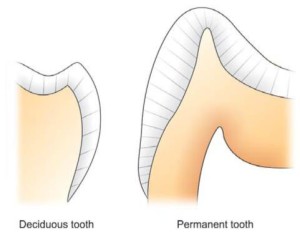 KIDDO TEETH ARE FRAGILE!
KIDDO TEETH ARE FRAGILE! In infants, a specific pattern of decay,
In infants, a specific pattern of decay, 